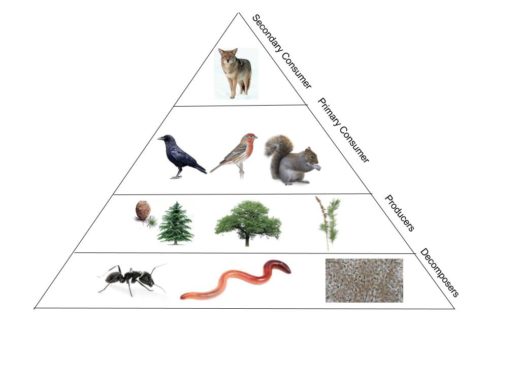
Illustration by Benjamin Minch.
By Benjamin Minch, Staff Writer
Fountain Valley is home to a diverse system of organisms that interact in a highly complex set of interactions. I have developed the first trophic pyramid for these interactions in the Fountain Valley area, which is a chart to show the transfer of energy in an ecosystem.
Fountain Valley is in a Chaparral Forest biome, meaning that it receives very little rainfall and moderate temperatures that remain constant throughout the year. Here is a climatogram showing the average temperatures and rainfall throughout the year.
This fairly dry climate and constant temperatures allow for a specific set of organisms to thrive here. Many of our plants are thin-leaved and waxy to compensate for the lack of rainfall because those leaves lose less water. These plants are the basis for building this complex ecosystem as plants are the main determinants of which animals will live there.
Producers
The producers in the area of Fountain Valley consist mostly of trees such as Oaks or Coniferous pine trees in Mile Square Park. This however, isn’t the only source of producers because the majority of our producers are actually house plants. We still do not know the immense impact these home gardens have on biodiversity, but many new species can thrive because of these plants, such as honeybees, aphids and various other organisms you cannot find in normal Chaparral forests.
These houseplants aren’t drought resistant and don’t need to be because they are watered artificially by humans.
Decomposers
The decomposers in Fountain Valley are typical of wherever you go because decomposers, of all organisms, change the least from biome to biome. This is because their habitat isn’t as reliant on temperature or precipitation, as it is reliant on organic material available and soil quality.
Earthworms, ants and decomposing bacteria in the soil are the main contributors to decomposition in Fountain Valley as well as pill bugs and other various insects. These organisms are responsible for the recycling of materials in the soil such as carbon, nitrogen and phosphorus. These organism eat and break down dead organisms or detritus in order to release the stored materials into the soil such as carbon. This carbon is then released as CO2 or is absorbed directly by a plant in the area.
Primary Consumers
Primary consumers make up one of the greatest percentages of visible life in Fountain Valley and of almost any ecosystem. Even though there are more decomposers in the soil, they are not always visible for that exact reason. Consumers such as finches, squirrels and various types of insects take up the majority of what we see.
These animals are mostly herbivores or eat decomposers such as worms or insects in the soil. They are so abundant because of the 10% rule, which states that only 10% of energy moves onto the next level of the trophic pyramid. This means that only 10% of the plant’s energy is being transferred to the consumer. As you go up the trophic pyramid, the amount of energy becomes less and less, which is one of the reasons why secondary consumers are so scarce.
Secondary Consumers
Secondary consumers such as an owl or coyote are much less prominent because of the limiting factor of food in the area. These animals prey on primary consumers such as squirrels, mice and sometimes housepets as well. Secondary consumers usually have something called a carrying capacity, which is the maximum number of species that can thrive in a given ecosystem. This is usually caused by a lack of food and is controlled from the bottom up.
These secondary consumers are most commonly seen at night because they depend on stealth to catch their prey. They also don’t want to call too much attention to themselves because they have probably experienced human damage in the past.
Using this trophic pyramid, we can better protect our ecosystem by recognizing where problems are coming from. If we notice a lack in the number of squirrels, we can deduce that it is either caused by a lack of habitats and food (producers) or an excessive amount of predators (secondary consumers). Controlling these numbers can help us keep our ecosystem in equilibrium and will ensure that it sustains to the next generation.





